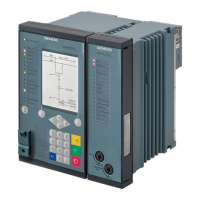Synchronization Function
Overview of Functions
The Synchronization function (ANSI 25) checks whether the activation is permissible without a risk to the
stability of the system when interconnecting 2 parts of an electrical power system.
Typical applications are as follows:
•
The synchronization of a line and a busbar
•
The synchronization of 2 busbars via a cross-coupling
•
The synchronization of a generator and a busbar
A power transformer between the 2 measuring points can also be taken into consideration.
The following operating modes are covered:
•
Synchrocheck
•
Switching synchronous power systems
•
Switching asynchronous power systems
•
Switching to dead line/busbar
Structure of the Function
The Synchronization function is used in the Circuit-breaker function group.
The following stage types can be used within the function:
•
Synchrocheck stage
•
Synchronous/asynchronous stage
The Synchrocheck and Synchronous/Asynchronous (Sychr./Asycr.) stage types are preconfigured at the
factory.
In addition, the stage type Extended delta-f options are available in the function library. This has not been
preconfigured.
You can operate a maximum of 2 stages of the Synchrocheck stage type or 6 stages of the Synchronous/
asynchronous in parallel.
As soon as the function is available in the device, the functional measured values are calculated and displayed.
6.4
6.4.1
6.4.2
Control Functions
6.4 Synchronization Function
360 SIPROTEC 5, High-Voltage Bay Controller, Manual
C53000-G5040-C015-9, Edition 11.2017

